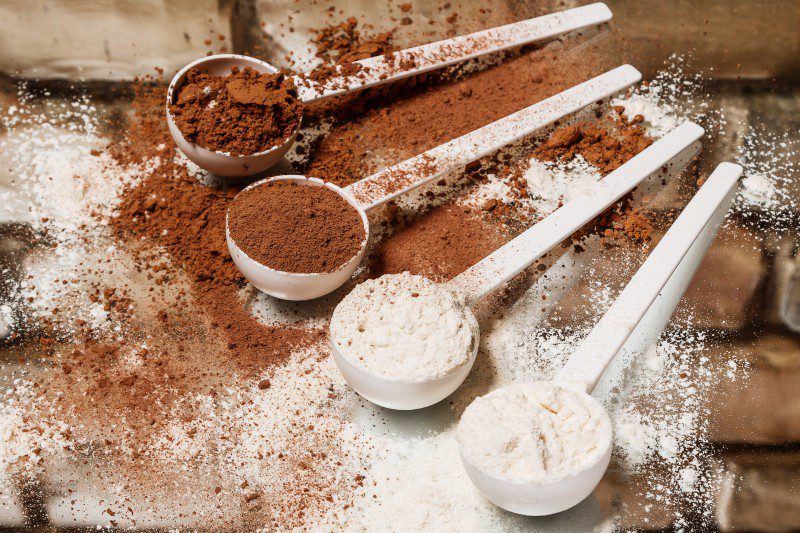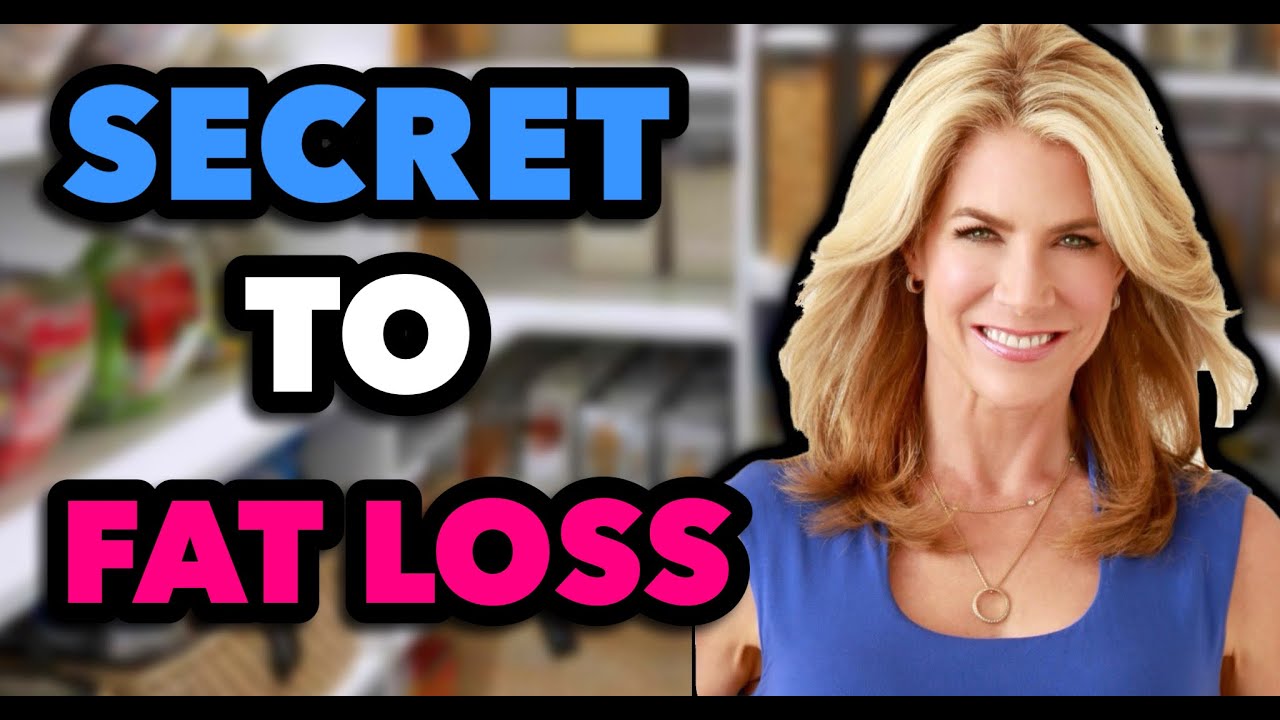You’ve read the latest research (and maybe even my article) describing the many benefits of protein. You know that getting optimal amounts means more energy and focus, stronger bones and muscles, glowing skin, and a leaner body.
You want all those things, which is why you’ve committed to getting 30–50 grams of protein in every meal. You’ve discovered that a creamy, satisfying, milkshake-tasting loaded smoothie is the most efficient way to meet this quota. And you’ve decided that using a protein powder is the most efficient way to meet that quota.
A fast, filling loaded smoothie is the most efficient way to get more protein. Need some yummy ideas? I’ve got over 60 recipes for loaded smoothies + more in this FREE Loaded Smoothie Cookbook, guaranteed to be a game-changer to hit your protein quota. Claim yours here.
How to Choose a Protein Powder
Unfortunately, choosing the right protein powder can be daunting. There are tons of different options out there now made with lots of confusing ingredients.
A few guidelines for choosing the right one:
- Fewer ingredients are better.
- If it contains sugar, make sure it is very low in added sugars (no more than 5 grams per serving).
- A small amount of natural alternative sweeteners, such as erythritol, stevia, or allulose, are fine. So are sugar alcohols.
- A stellar protein powder will go above and beyond, providing vitamins, minerals, antioxidants, fiber, and other nutrients.
- Avoid at all costs:
- Fructose (the most damaging sugar) in all its many forms, including high-fructose corn syrup.
- Artificial sweeteners
- Artificial flavors or colors
- Inflammatory oils
- Highly reactive ingredients, like soy, dairy, and egg
Protein Powder With Essential Amino Acids
You also want to make sure that the protein powder you choose has a solid amino-acid profile.
Amino acids fall into two categories:
- 11 non-essential amino acids, which the body can usually make on its own.
- 9 essential amino acids, which the body cannot make on its own, so we must get them from food.
Animal foods provide all the essential amino acids, which isn’t always the case with plant foods. As you’ll see though, having a variety of plant proteins in your diet can help you make sure you get all of those essential nutrients.
What’s the Difference Between Collagen Powder and Protein Powder?
Collagen powder and protein powder are both dietary supplements, but collagen is a specific type of protein, while protein powder is an umbrella term for various types of protein.
Collagen powder is made from the collagen protein found in animal sources such as cows, chickens, and fish. It is the body’s most abundant protein and is used as a supplement to support healthy skin, a strong gut, muscle growth, and more.
Collagen provides the following specific amino acids:
- Glycine: Makes up about one-third of the total amino-acid content of collagen and is important for the formation of collagen fibers.
- Proline: Supports the formation of collagen in the body and helps maintain the structural integrity of your connective tissue.
- Hydroxyproline: Important for the strength and stability of collagen fibers (which make up its structure).
- Arginine: Key for the production of collagen and also helps to improve blood flow around the body.
- Glutamic acid: Helps to strengthen the skin barrier, and also helps in cell growth and division.
- Lysine: Important for collagen production and also helps to improve the absorption of calcium in the body.
You’ll find this supplement in peptide form. Collagen peptides are smaller chains of amino acids that are more easily absorbed, making them easier for your body to use.
Adding a scoop of Collagen Peptides Powder to your All-In-One Shake provides the protein boost you need to support healthy bones, joints, GI health, skin health, and more.*
A Nutrition Expert’s Guide to Protein Powders
Some sources of protein work best when they’re combined with others, and there are a few you’ll want to adamantly avoid. Learn more and find out my go-to protein sources below.
Soy Protein
Soy protein powder comes from defatted soybeans, which means the manufacturer removed the fat to increase protein content. You may find it listed as soy concentrate, which is about 70% protein, or soy protein isolate, which is even more refined with about 90% protein content.¹
The soy we consume in America is very, very different from what Asian populations eat. I lived in Japan for a while, and I watched people there consume a little bit of miso or tempeh. They were not consuming the type (or the amount) of soy found in sports bars, protein powders, and other processed foods that we consume in the U.S.
Today, soy is ubiquitous in nutrition bars, cereals, and yogurts. Why? According to the U.S. Department of Agriculture, soybeans (along with corn) accounted for half of all U.S. cash crops in 2021.²
Our food industry cleverly repositions a cheap source of protein as a healthy option. Soy is a highly processed “food” that usually comes loaded with toxins and carcinogens, or potentially cancer-causing ingredients.³
My verdict: Soy is a junk ingredient that’s everywhere, even in “healthy” foods and beverages. Steer clear of soy-based protein powders. Be warned that they’re everywhere — soy can be an ingredient, even if it’s not soy protein, so read labels closely.
Worth noting: The federal Food Allergen Labeling and Consumer Protection Act (FALCPA) requires that all FDA-regulated packaged foods must state clearly on the ingredient label if the product contains soy. You’ll find this beneath the nutrition facts label, under the ingredients in bold text.
Whey Protein
Whey is a complete protein, meaning that it provides all nine essential amino acids.⁴
Your body absorbs whey very quickly, which is why you see bodybuilders chugging it post-workout. Unfortunately, that makes whey a lousy choice in a loaded smoothie. People report that they’re hungry an hour or two later.
Whey has other issues, too. For one, it’s dairy.
In The Virgin Diet, I highlight the many problems of dairy, including weight loss resistance and skin problems.
Whey can also raise insulin levels, and high insulin levels mean you’re more likely to store fat rather than burn it. In fact, one study found that whey could raise insulin levels more than white bread. Yikes!⁵
Finally, most whey is very cheaply produced, derived from cows producing low-quality milk. High heat and other processing methods can damage whey’s fragile amino acids.
My verdict: I say “no way” to whey. Despite its impressive protein profile, it comes at a cost for your health. But I get it; the creaminess of whey is second to none. At least that’s what I thought… until I found an even better protein powder (read on to learn what it is!).
Pea Protein
Pea protein is a vegan-friendly option. Because it is hypoallergenic, it’s also a good choice for those who have sensitivities to common allergens like wheat and dairy.⁶
For a plant-based protein, pea provides a solid amino acid profile (plant-based proteins sometimes lack one or more of the essential nine). One review looked at the content and digestibility of protein sources and found that pea contained an impressive balance of both essential and nonessential amino acids.⁷
Compared with soy, pea (especially in isolate form) contains much lower amounts of lectins, oxalates, phytates, and other anti-nutrients.⁸ Anti-nutrients are naturally occurring compounds that can interfere with the absorption of vitamins and minerals, including calcium and zinc. As a result, anti-nutrients may create deficiencies in these areas.
My verdict: Pea protein is one of the better plant-based options with a good amino-acid profile, but you’ll want to look for a product that blends pea with other plant proteins to get all the essentials. Plus, some people find pure pea protein to have a gritty texture.
Look for a pea protein isolate derived from non-GMO, North American-grown yellow peas. An ideal climate and soil quality, along with state-of-the-art farming techniques, make these the highest-quality peas.

Chia Protein
Chia seeds are small, but mighty. They contain protein, fiber, omega-3 fatty acids, and several essential minerals and antioxidants, which helps manage blood sugar balance, inflammation levels, blood pressure, and more.⁹ Chia also contains all nine essential amino acids, making it a complete protein.¹⁰
Manufacturers make chia protein by separating the oils from the seeds, creating a powder that’s high in protein.
I know not everyone loves the texture of chia seeds, but you don’t have to worry about it getting slimy in your protein powder. High-quality chia protein powder should be smooth and easy to mix with liquids.
My verdict: I like chia because it contains alpha-linolenic acid (ALA), an anti-inflammatory omega-3 fatty acid. As a powder, you’ll often find chia blended with other plant-based proteins, which helps break down any clumps and improves overall texture. This gives it a better overall amino acid profile and better texture.
Hemp Protein
While hemp does contain all nine essential amino acids, it is low in lysine, so you may want to find a blend if you’re looking for a well-rounded protein powder.
A serving size of hemp protein powder provides about 15 grams of protein, which researchers note can easily be broken down in your body compared to other protein powders.
Along with an impressive seven to eight grams of fiber, many powders provide a few critical minerals as well, including magnesium and iron. Hemp also contains compounds called lignanamides, powerful antioxidants that can also help manage inflammation levels.¹¹
My verdict: Hemp is another good source of the anti-inflammatory omega-3 fatty acid ALA. As a powder, it has a slightly grittier taste than some other proteins. You’ll often find it combined with other plant-based proteins, which gives it a better amino acid profile.
Chlorella Protein
Chlorella is a type of nutritious algae containing about 50–60% protein, with all nine essential amino acids.
Chlorella also provides vitamin B12, vitamin C, omega-3 fatty acids, tiny amounts of minerals like magnesium and zinc, and antioxidants including chlorophyll, beta-carotene, lycopene, and lutein.¹²
Among its benefits, research shows that chlorella can support immune health, and blood sugar balance, and support the detoxification of heavy metals.¹³
My verdict: As a protein powder, chlorella is often combined with other plant-based proteins for a more well-rounded amino acid profile and better flavor (it can be quite bitter and earthy on its own). I’ve also found that the occasional complaints people have about chlorella, including stomach upset, can be mitigated by combining chlorella with other proteins.
Beef Protein
Beef protein powder is my go-to protein source for a supplement. As a complete protein, it provides all nine essential amino acids along with the nutrients needed to make collagen.
The functional peptides, or small chains of amino acids, in beef protein allow your body to better absorb and utilize these amino acids.
I know, you might be wondering about how protein sourced from beef will taste. But I promise that you’re not going to end up with a steak-flavored smoothie!
Beef protein is virtually flavorless, making it a great way to boost the content of any meal without altering its taste. Plus, it offers the creaminess and texture of whey in your smoothies — without the downsides of dairy.
Research about beef protein has been promising. One review of seven studies found that beef protein provides similar effects to whey for improved body composition, increased muscle strength, and increased total daily protein intake.¹⁴
My verdict: Beef protein is my all-around favorite protein powder. It has a great amino-acid profile and a nutrient composition that is very similar to bone broth. You essentially get all of bone broth’s amazing health benefits — without having to spend hours simmering it yourself.
How I Designed the Best Protein Powders on the Market
Vegetarians and vegans are particularly prone to protein deficiencies, but I’ve found that almost everyone, including athletes and carnivores, can benefit from getting more protein in their diet. A powder supplement is the easiest way to boost your protein intake, but as you’ve seen, some are better than others.
I know how confusing buying a protein powder can be, which is why I designed my own. I created two types. Both provide superior absorption and potent amounts of protein, and deliver the absolute best milkshake-y texture and flavor of any protein powder on the market.*
Here’s how to choose:
If you’re on a paleo diet and/or prefer the amino-acid profile of animal-based protein powders:
- My Paleo-Inspired All-In-One Shakes provide beef protein as HydroBEEF™, which is a highly concentrated protein that mimics the nutrient profile of bone broth. It is over 97% protein, with a very high protein usability score (this measures how well the body is able to utilize a protein).
- Remember, when it comes to animal-based proteins, you are what you eat, ate. HydroBEEF™ comes from cows raised in Sweden without hormones and free of any genetically modified (GMO) grains, grasses, and hay. The unique manufacturing process allows higher protein absorption.
- Every serving provides 20 grams of high-quality protein along with vitamins, minerals, and phytonutrients, with just one gram of total sugar.*
- With Paleo-Inspired All-In-One Shakes, I’ve finally found a protein powder that rivals the creamy, satisfying taste of whey protein… without the reactivity of whey. You’re not going to believe how milkshake-like this tastes!
If you’re vegan, vegetarian, or otherwise prefer a plant-based protein:
- Plant-Based All-In-One Shakes blend three types of plant protein: pea, chia, and chlorella. Combining them provides a complete amino-acid profile and 22 grams of protein per serving, along with vitamins, minerals, fiber, nine different fruits and veggies, and the gut and immune support of probiotics.*
- This customized protein blend provides a you’ll-swear-it’s-dessert flavor, with none of the grittiness or weird aftertaste that other plant-based proteins can have. I taste-tested dozens of blends, and this one was hands down my favorite!
When it comes to protein powders, the flavor is everything. And I can confidently say that after tasting many powders, our All-In-One Shakes are the best tasting on the market. Whichever one you choose, you can rest assured they contain NO dairy, soy, gluten, eggs, sugar, artificial sweeteners, or GMOs.
Order your All-In-One Shakes here.
*These statements have not been evaluated by the Food & Drug Administration. Products mentioned are not intended to diagnose, treat, cure, or prevent any disease. The views in this blog by JJ Virgin should never be used as a substitute for professional medical advice. Please work with a healthcare practitioner concerning any medical problem or concern.
References:
- Hoffman JR, Falvo MJ. Protein — Which is Best? J Sports Sci Med. 2004 Sep 1;3(3):118–30. PMID: 24482589; PMCID: PMC3905294.
- https://www.ers.usda.gov/data-products/chart-gallery/gallery/chart-detail/?chartId=76946
- Daniel, Kaalya. The Whole Soy Story. MD: Newtrends Publishing, Inc.; 1st edition (March 10, 2005).
- https://www.agropur.com/us/news/pdcaas-to-diaas-a-new-way-to-look-at-protein-quality
- Salehi A, Gunnerud U, Muhammed SJ, Ostman E, Holst JJ, Björck I, Rorsman P. The insulinogenic effect of whey protein is partially mediated by a direct effect of amino acids and GIP on β-cells. Nutr Metab (Lond). 2012 May 30;9(1):48. doi: 10.1186/1743–7075–9–48. PMID: 22647249; PMCID: PMC3471010.
- https://health.clevelandclinic.org/pea-protein/
- Sousa R, Portmann R, Dubois S, Recio I, Egger L. Protein digestion of different protein sources using the INFOGEST static digestion model. Food Res Int. 2020;130:108996. doi:10.1016/j.foodres.2020.108996.
- Petroski W, Minich DM. Is There Such a Thing as “Anti‑Nutrients”? A Narrative Review of Perceived Problematic Plant Compounds. Nutrients. 2020;12(10):2929. Published 2020 Sep 24. doi:10.3390/nu12102929.
- https://www.healthline.com/nutrition/chia-seeds
- https://www.healthline.com/nutrition/chia-seeds
- https://www.healthline.com/nutrition/hemp-protein-powder
- https://www.healthline.com/nutrition/benefits-of-chlorella
- https://www.healthline.com/nutrition/benefits-of-chlorella
- Valenzuela PL, Mata F, Morales JS, Castillo-García A, Lucia A. Does Beef Protein Supplementation Improve Body Composition and Exercise Performance? A Systematic Review and Meta-Analysis of Randomized Controlled Trials. Nutrients. 2019 Jun 25;11(6):1429. doi: 10.3390/nu11061429. PMID: 31242624; PMCID: PMC6628355.





